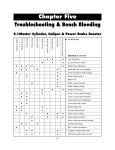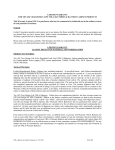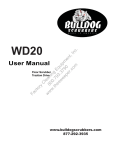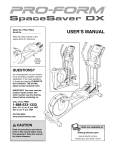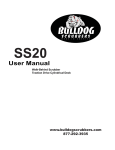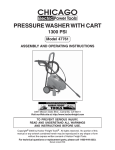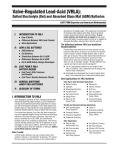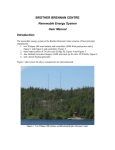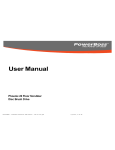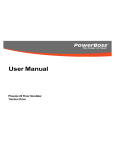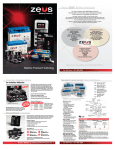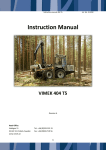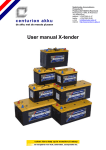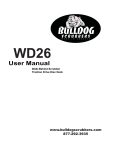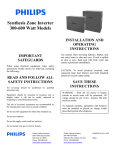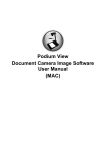Download 1112 (Unigy II I & O) - East Penn Manufacturing
Transcript
® S P A C E S A V E R® SYSTEMS Interlock 45, 75, 95 & 125 AH Non-Interlock 45, 75 & 95 AH ™ ™ Installation and Operation Manual California Proposition 65 Warning: Batteries, battery posts, terminals and related accessories contain lead and lead compounds, and other chemicals known to the state of California to cause cancer and birth defects or other reproductive harm. Wash hands after handling. TABLE OF CONTENTS Safety Precautions Protective Equipment ......................................3 Procedures ......................................................3 Record Keeping Voltages, Temperatures & Ohmic Readings ..........................................6 Receiving & Storage Receiving Inspection........................................3 Unpacking ........................................................3 Storage ............................................................3 Maintenance Annual Inspection ............................................7 Rectifier Ripple Voltage....................................7 Battery Cleaning ..............................................7 Capacity Testing ..............................................7 Installation Cell Removal Procedure..................................7 General ............................................................4 Grounding ........................................................4 Electric Code for Maintenance Access ............4 Floor Anchoring & Module Arrangements ......4 Module Installations ........................................4 FIGURES ......................................................7-17 APPENDIX A Recharge Interval Chart ..............................18 APPENDIX B Voltage Compensation Chart......................19 Electrical Connection Connector Assembly........................................4 Terminal Assembly ..........................................4 Final Assembly Check Procedure ......................5 Parallel Strings ................................................5 Module Front Shield Assembly ........................5 Top Protective Shield Assembly ......................5 Terminal Plate Shield Assembly ......................5 APPENDIX C Battery Maintenance Report ......................20 APPENDIX D UNIGY II SPACESAVER® System Acid Volumes & Weights ............................21 System Operations Charger Voltage ..............................................6 Operating Temperatures ................................6 Cell Voltage ......................................................6 Equalizing ........................................................6 BATTERIES AND RELATED PARTS CONTAIN LEAD WASH HANDS AFTER HANDLING! CALIFORNIA PROPOSITION 65 WARNING: Batteries, battery posts, terminals and related accessories contain lead and lead compounds, and other chemicals known to the state of California to cause cancer and birth defects or other reproductive harm. California Proposition 65 Workplace Warning Sign Must be posted in workplace near batteries. 2 7/04 SAFETY PRECAUTIONS DANGER VRLA (Valve Regulated Lead-Acid) batteries have the electrolyte immobilized within the cell; however, electrical hazard associated with batteries still exists. Work performed on these batteries should be done with the tools and the protective equipment listed below. VRLA battery installations should be supervised by personnel familiar with batteries and battery safety precautions. HIGH VOLTAGE... RISK OF SHOCK. DO NOT TOUCH UNINSULATED TERMINALS OR CONNECTORS. SHIELD EYES. EXPLOSIVE GASES CAN CAUSE BLINDNESS OR INJURY. SULFURIC ACID CAN NO •SPARKS CAUSE •FLAMES BLINDNESS OR •SMOKING SEVERE BURNS. WARNING: Risk of fire, explosion or burns. Do not disassemble, heat above 40°C, or incinerate. Protective Equipment FLUSH EYES IMMEDIATELY WITH WATER. GET MEDICAL HELP FAST. SEE INSTALLATION, MAINTENANCE AND OPERATION INSTRUCTIONS FOR IMPORTANT SAFETY PRECAUTIONS. Although VRLA batteries can vent or leak small amounts of electrolyte, electrical safety is the principle but not the only concern for safe handling. Per IEEE 1188 recommendations, the following minimum set of equipment for safe handling of the battery and protection of personnel shall be available: 1. Safety glasses with side shields, or goggles, or face shields as appropriate. (Consult application specific requirements) 2. Electrically insulated gloves, appropriate for the installation. 3. Protective aprons and safety shoes. 4. Portable or stationary water facilities in the battery vicinity for rinsing eyes and skin in case of contact with acid electrolyte. 5. Class C fire extinguisher. 6. Acid neutralizing agent. 7. Adequately insulated tools. 8. Lifting devices of adequate capacity, when required. VENTILATE WELL WHEN IN AN ENCLOSED SPACE AND WHEN CHARGING. DO NOT REMOVE VENT VALVE. WARRANTY VOID IF VENT VALVE IS REMOVED. California Proposition 65 Warning: Batteries, battery posts, terminals and related accessories contain lead and lead compounds, and other chemicals known to the state of California to cause cancer and birth defects or other reproductive harm. Wash hands after handling. Fig. 1-1 RECEIVING & STORAGE Receiving Inspection Upon receipt, and at the time of actual unloading, each package should be visually inspected for any possible damage or electrolyte leakage. If either is evident, a more detailed inspection of the entire shipment should be conducted and noted on the bill of lading. Record receipt date, inspection data and notify carrier of any damage. Procedures The following safety procedures should be followed during installation: (Always wear safety glasses or face shield when working on or near batteries. Refer to Figure 1) 1. These batteries are sealed and contain no free electrolyte. Under normal operating conditions, they do not present any sulfuric acid danger. However, if the battery jar or cover is damaged, sulfuric acid could be present. Sulfuric acid is harmful to the skin and eyes. Flush affected area with water immediately and consult a physician if splashed in the eyes. Consult SDS for additional precautions and first aid measures. SDS sheets can be obtained at www.eastpennmanufacturing.com. 2. Prohibit smoking and open flames, and avoid arcing in the immediate vicinity of the battery. 3 Do not wear metallic objects, such as jewelry, key chains, while working on batteries. Do not store un-insulated tools in pockets or tool belt while working in vicinity of battery. 4. Keep the top of the battery dry and clear of tools and other foreign objects. 5. Provide adequate ventilation (per IEEE standard 1187 and/or Federal, State & Local codes) and follow recommended charging voltages. 6. Never remove or tamper with the pressure relief valves, unless for cell removal. Warranty void if vent valve is removed. 7. Inspect all flooring and lifting equipment for functional adequacy. 8. Adequately secure battery modules, racks, or cabinets to the floor. 9. Connect support structures to ground system in accordance with applicable codes. 10. The below IEEE Standards contain additional information. Other standards may be relevant to your specific application. Unpacking 1. Always wear eye protection. 2. Check all batteries for visible defects such as cracked containers, loose terminal posts, or other unrepairable problems. Batteries with these defects must be replaced. 3. Check the contents of the packages against the packaging list. Report any missing parts or shipping damage to your East Penn agent or East Penn Mfg. Co. immediately. 4. Never lift batteries by the terminal posts. 5. When lifting batteries, the proper equipment is needed such as a forklift or a portable crane. Always check the lifting capacities of the equipment being used and never lift more than one module and or cell at a time. Storage 1. Cells should be stored indoors in a clean, level, dry, cool location. Recommended storage temperature is 0°F to 90°F (–18°C to 32°C). 2. Stored lead-acid batteries self discharge and must be given a boost charge to prevent permanent performance degradation. 0°F to 77°F (-18°C to 25°C) storage: Batteries should be recharged six months from date of manufacture. >77°F (25°C) storage: Use the chart in Appendix A for recharge intervals. Voltage readings should be taken on a monthly basis. Cells that reach 2.10 volts per cell should be recharged regardless of scheduled interval. Record dates and conditions for all charges during storage. 3. If a boost charge is required: the recommended charge is 24 hours at a constant voltage equal to 2.40 volts per cell. 4. Do not store beyond 12 months. 5. Store in horizontal position only. IEEE 1187 – Recommended Practice for Installation Design of VRLA Batteries IEEE 1188 – Recommended Practice for Maintenance, Testing, of VRLA Batteries IEEE 1189 – Selection of VRLA Batteries for Stationary Applications 3 Connector Assembly (con’t) INSTALLATION General 2. The Interlock™ and Non-Interlock™ battery (45, 75 & 95 AH) are supplied with connector package “1CU” requiring one connector per post. Install the connectors loosely to allow for final alignment, then torque to 125 ± 5 inch pounds (14.1 ± .5 Nm.) The installation and direction of the post bolts is important! (Refer to Fig. 4-1, 4-2 and 4-3 pg. 11 and 12; Fig. 4-4, pg. 4. For proper direction when inserting into posts.) The 125 AH battery is supplied with a 2CU connector package as standard. (Refer to Fig.5-1A, pg. 13 for special connector orientation for side terminal & stack to stack connections.) 3. Batteries used in high rate discharge applications require multiple connectors per connection. (Refer to optional connector packages in Fig. 4-5, pg. 4) Caution should be taken when installing batteries to insure no damage occurs. The battery cabinet, tray, rack, etc. shall be inspected for sharp edges that could cause damage to the battery casing. Batteries shall not be dropped, slid, or placed on rough or uneven surfaces such as tray lips or grated flooring. Mishandling of batteries could result in equipment damage or human injury. East Penn will not be liable for damage or injury as a result of mishandling or misuse of the product. Grounding When grounding the battery system, proper techniques should be applied per electrical standards, such as NEC and/or local codes, as well as user manual of specific applications. Two .201 diameter x .750 center holes are provided in back of each module to accept a #6 x .750 center compression grounding lug. The holes must be tapped for a 1/4-20UNC thread and paint must be removed for a proper grounding pad location. Electric Code for Maintenance Access Refer to ANSI/NFPA-70 National Electric Code for access and working space requirements around the battery. A minimum of 36" aisle space is recommended in front of the battery for service and inspection.* *Note: Battery system and/or individual module grounding, if required, is the installer’s responsibility. Floor Anchoring & Module Arrangements See East Penn Mfg. Co.’s schematic diagram illustration. One is supplied with each shipment. If it cannot be located, contact East Penn Mfg. Co. for a copy. Refer to your delivery number, located on the packing slip. This will aid in obtaining the proper drawing. Fig. 4-4 Module Installations Connector Packages Assemble modules per the following details. CAUTION: Never lift more than one module at a time with the lifting slings. (See Fig. 3-2, pg. 9.) 1. UBC Zone 4 hardware included for Interlock™ module assembly (45, 75 & 95 AH). (See Fig. 3-4, pg. 10) 2. Unbolt the floor-mounting channel from the top of the battery. 3. Use the two slings provided to lift modules. Note: For Interlock™ module lift the top module slightly and slide front. (This will release the interlock tabs and will free itself from the remaining stack.) (See Fig. 3-2, pg. 9) 4. For the Non-Interlock modules, reference figure 3.5, pg. 11 for marking hole locations to mount base supports to floor. For the Interlock modules, use 1-piece base for marking floor hole location. (See local building codes for anchor bolt requirements, anchor bolts not included.) 5. Remove the next module in the same manner as the first. Place in position. Note: For Interlock™ module slide back allowing the tabs to lock in place. (No rear bolts required) (See Fig. 3-2, pg. 9) Standard Package (45, 75 & 95 AH) 1CU: (1) 1⁄8" connector / post ≤ 250 amps / 480 wpc (5-15 plate) ≤ 450 amps / 720 wpc (17-27 plate) ≤ 550 amps / 880 wpc (29-33 plate) Optional Packages 2CU: (2) 1⁄8" connectors / post (Standard on 125 AH) ≤ 1000 amps / 1600 wpc (9-33 plate) 4CU: (4) 1⁄8" connectors / post ≤ 2000 amps / 3200 wpc (13-33 plate) 6CU: (6) 1⁄8" connectors / post ≤ 3000 amps / 4800 wpc (25-33 plate) Corresponding Bolt Package 1CU: 1⁄4-20 x 11⁄4" long — JMP1428 2CU: 1⁄4-20 x 11⁄2" long — JMP1407 4CU: 1⁄4-20 x 13⁄4" long — JMP1435 6CU: 1⁄4-20 x 2" long — JMP1409 Fig. 4-5 Terminal Assembly 1. Attach the terminal mounting bracket to the module frame. (See Fig. 5-1, pg. 13 for Interlock™ and Fig. 5-2 and 5-2A for Non-Interlock™, pg. 14 for Side Terminal; See Fig. 5-3 and Fig. 5-3A, pg. 15 for Top Terminal) 2. Attach the terminal plates or the terminal connectors to the battery posts and then torque to 125 ± 5 inchpounds (14.1 ± .5 Nm). (See Fig. 5-3 and Fig. 5-3A, pg. 15 for 95 AH vs. 125 AH) 3. For cable connection assembly, (See Fig. 7-1, pg. 16 and Fig. 7-1A, pg. 17.) 6. Each battery is shipped with its own schematic. Make sure the polarity on the batteries match the drawings. ELECTRICAL CONNECTION Connector Assembly 1. The contact surfaces of each individual post on every cell have been cleaned and coated with a thin film of no-ox-ID “A” grease at the factory. Assure the contact surfaces are free of dust or dirt prior to assembly. 4 Final Assembly Check Procedure Top Protective Shield Assembly 1. For future identification of all cells, number individual cells in sequence, beginning with number one (1) at the positive end of the battery. The last cell of the battery is located at the negative output terminal. 2. Read and record the voltages of the individual cells to assure that they are connected properly. The total battery voltage should be approximately equal to the number of cells connected in series multiplied by the measured voltage of one cell. If the measurement is less, recheck the connections for proper polarity. Verify that all cell and battery connections have been properly torqued. 3. Measure and record the intercell connection resistance using a micro-ohms meter. This helps determine the adequacy of initial connection installation and can be used as a reference for future maintenance requirements. Refer to the recording forms in Appendix C of this manual. Review the records of each connection and detail resistance measurements. Clean, remake, and remeasure any connection that has a resistance measurement greater than 10% of the average of all the same type connections (i.e. intercell, intermodule, etc.). 4. Battery performance is based on the output at the battery terminals. Therefore, the shortest electrical connection between the battery system and the operating equipment results in maximum total system performance. Select cable size based on current carrying capability and voltage drop. Cable size should not provide a greater voltage drop between the battery system and operating equipment than specified. Excessive voltage drop in cables will reduce the desired reserve time and power from the battery system. For side terminal assembly, attach the black top protective cover to the highest front shield. For top terminal assembly, cut the black protective cover to fit between the terminals and then attach to the front shield. (See Fig. 5-4, pg. 16.) Terminal Plate Shield Assembly For side terminal shield assembly, (Refer to Fig. 5-1, pg 13 for Interlock™ and Fig. 5-2 and 5-2A for Non-Interlock™, pg. 14 and Fig. 5-7, pg. 5) For top terminal shield assembly, (Refer to Fig. 5-3, pg. 15 and Fig. 5-8, pg. 5) Fig. 5-6 Parallel Strings When paralleling valve-regulated batteries, the capacity, arrangement, and external circuit length should be identical for each battery. Wide variation in the battery circuit resistance can result in unbalanced charging (i.e., excessive charging currents in some batteries and undercharging in others). As a result, cell failures in one battery string and subsequent loss of performance capabilities of that string will result in higher loads in the other parallel string(s), which may exceed the ratings of the battery connections. This can damage the battery system and dramatically shorten battery life. Module Front Shield Assembly 1. Attach one black clip to each end of the clear shield. (See Fig. 5-4, pg. 16 and 5-5, pg. 5.) 2. Install the fully assembled shield into the tabs on the module. (See Fig. 5-6, pg. 5 & Fig. 5-4, pg. 16) Fig. 5-7 Fig. 5-8 Fig. 5-5 5 Voltages, Temperatures & Ohmic Readings (con’t) While it is acceptable to operate at temperatures less than 77˚F (25˚C), it will require longer charging time to become fully recharged. Also, the capacity will be less at operating temperatures below 77˚F (25˚C). After installation and when the batteries have been on float charge for one week, the following data should be recorded: 1. Battery terminal voltage 2. Charger voltage 3. Individual cell float voltages 4. Individual cell ohmic readings. On a 4-post cell place meter leads on the left positive - left negative posts or right positive - right negative posts. For 6-post cells, measure from center positive - center negative posts. Do not measure diagonally from positive to negative posts. (See Fig. 6-1, pg. 6.) 5. Ambient temperatures 6. Terminal connections should be checked to verify that the installer did torque all connections properly (125 ± 5 in.-lbs.). Micro-ohm readings should be taken across every connection. (Refer to Fig. 6-2, pg. 6) Refer to meter manufacturer’s instructions for proper placement of probes. If any reading differs by more than 20% from its initial installation value, re-torque the connection to 125 ± 5 inch-pounds. If the reading still remains high, clean contact surfaces according to Step 2 under Connector Assembly. SYSTEM OPERATIONS Charger Voltage These batteries are designed for continuous float applications. Float / Standby 2.25 vpc ± 0.01 @ 77°F (25°C) When setting the float voltage on the charger, the system should be set to float at the nominal cell float voltage times the number of cells per string. The charger must be able to maintain the system voltage within ± 0.5% of the desired level at all times. The desired float voltage varies with temperature according to the table in the next column. Temperature Compensation Battery voltage should be adjusted for ambient temperature variations. 2mV per °C (1.8°F) per cell Consult Voltage Compensation Chart in Appendix B for temperature compensation voltage maximum and minimum limits Battery Operation Battery operating temperature will affect battery capacity and operating life. Operation at temperatures greater than 77°F (25°C) will reduce the operating life of the battery. For every 13°F (7°C) increase in operating temperature above 77°F (25°C), the warranty period will be proportionally reduced by 50% as shown below: Operating Temp. Proportional % of Life 77°F (25°C) 100% 81°F (27°C) 80% 87°F (30°C) 60% 90°F (32°C) 50% The average cell operating temperature should not exceed 95°F (35°C) and should never exceed 105°F (40.5°C) for more than an eight-hour period. If operating temperatures are expected to be in excess of 95°F (35°C), contact East Penn for recommendations. Discharging at temperatures less than 77°F (25°C) will reduce the capacity of the battery. Cells must not be operated below 50°F (10°C). If operating temperatures are expected to be less than 50°F (10°C), contact East Penn for recommendations. Batteries must be located in a manner that the individual cells do not vary by more than 5°F (2.8°C) between the lowest and highest individual cell temperatures. Cell Voltage Fig. 6-1 Although the charger must maintain the system voltage within ± 0.5%, individual battery [cell] voltages may vary by ± 0.05 volts per cell of the average cell float voltage. Equalizing Upon installation of the battery system, an optional charge of 14.40V per battery ± 0.06 @ 77°F (25°C) [2.40 vpc ± 0.01 @ 77°F (25°C)] for 24 hours (not to exceed 24 hours) can be applied. (Note: Verify that the higher battery voltage will not adversely affect any other connected equipment). If this is done, be sure to reset the charging equipment to the proper float voltage. RECORD KEEPING Voltages, Temperatures & Ohmic Readings Record keeping is an important part of stationary battery maintenance and warranty coverage. This information will help in establishing a life history of the battery and inform the user if and when corrective action needs to be taken. (Refer to Appendix C, Battery Maintenance Report) Fig. 6-2 6 Failure to maintain proper records including information as detailed above may result in voiding any applicable warranty. MAINTENANCE CELL REMOVAL PROCEDURE Always wear eye protection when working on or near batteries. Keep sparks and open flames away from batteries at all times. See Safety Precautions on pg. 3. Annual Inspection 1. Before removing cells, review Safety Precautions on pg. 3 of this manual. Contact East Penn Manufacturing Company, Inc. with specific questions or concerns. 2. Refer to Fig. 8-1 through 8-4 below for specific instructions. (1) 1. Conduct a visual inspection of each cell. 2. Record the battery string voltage. 3. Record the charger voltage. 4. Record the individual cell voltages. The accuracy of the DMM (Digital Multimeter) must be .05% (on dc scale) or better. The DMM must be calibrated to NIST traceable standards. Because float readings are affected by discharges and recharges, these readings must be taken when batteries have been on continuous, uninterrupted float for at lease one month. Cells should be within ± 0.05 volts of the average cell float voltage. 5. Record the ambient temperatures. 6. Record individual cell ohmic readings. 7. Record all interunit and terminal connection resistances. Micro-ohm readings should be taken during this inspection. If any reading differs by more than 20% from initial readings taken, retorque the connection. Recheck the micro-ohm reading. If the reading remains high, clean the contact surface according to installation portion of this manual. (1) Other Maintenance Inspection intervals follow IEEE 1188 STEP 1: HARDWARE REMOVAL 1. DISCONNECT CHARGER. 2. DISCONNECT THE SYSTEM GROUND CONNECTION. 3. REMOVE MODULE FRONT SHIELD ASSEMBLY. REMOVE THE CELL RETAINER BAR. 4. DISCONNECT THE CELL FROM OTHER CELLS IN SERIES. CONNECTOR RETAINER BAR 1/4-20 X 1" LG THREAD CUTTING SCREW (INTERLOCK) 1/4-20 HEX NUT (STANDARD) Fig. 8-1 STEP 2: PRESSURE RELIEF 1. PRY VENT SHROUD OFF. 2. REMOVE FLAME ARRESTOR. 3. UNSCREW VALVE WITH 17mm HEX KEY. (PRESSURE WILL RELEASE) 4. RETORQUE VALVE IMMEDIATELY TO 12-14 in.lbs. WITH 17mm HEX KEY. Rectifier Ripple Voltage CATALYST VALVE FREQUENCY Ripple that has a frequency greater than 667Hz (duration less than 1.5ms) is acceptable, unless it is causing additional battery heating. Ripple that has a frequency less than 667Hz (duration greater than1.5ms), must meet the following voltage specification to be acceptable. VOLTAGE Ripple voltage shall be less than 0.5% peak to peak of the manufacturer’s recommended string voltage. Failure to comply can void the warranty. FLAME ARRESTOR SHROUD Fig. 8-2 STEP 3: CELL REMOVAL 1. THREAD POLYPROPYLENE ROPE THROUGH TWO TERMINALS AS SHOWN AND KNOT. 2. PULL CELL FROM MODULE ACROSS LIFT TRUCK AS SHOWN. Battery Cleaning Batteries, cabinets, racks, and modules should be cleaned with clear water, a mixture of baking soda and water or East Penn Mfg supplied battery cleaner (part # 00321). Never use solvents to clean the battery. POLYPROPYLENE ROPE ACID RESISTANT GLOVE Capacity Testing Per IEEE 1188 “Capacity testing is used to trend battery aging. The result of a capacity test is a calculation of the capacity of the battery. The calculated capacity is also used to determine if the battery requires replacement.” Do not discharge the battery beyond the specified final voltage. When discharging at higher rates, extra connectors may need to be added to prevent excessive voltage drop and / or excessive temperature rise. When performing capacity testing and recording data use IEEE 1188 instructions. Should it be determined that any individual battery (ies) [cell(s)] need to be replaced, contact East Penn. Fig. 8-3 STEP 4: CELL REPLACEMENT 1. CHECK POLARITY ORIENTATION. PUSH CELL BACK INTO MODULE. 2. REMOVE ROPE IF USED. 3. REPLACE RETAINER BARS. 4. REPLACE CONNECTORS. 5. REPLACE MODULE FRONT SHIELD. 6. RECONNECT SYSTEM GROUND CONNECTION. 7. RECONNECT CHARGER. Fig. 8-4 7 SHIPPING BOX TOP TERMINAL BRACKET SUPPORT CHANNEL ACCESSORY PACKAGE SEE PARTS LIST FOR COMPONENTS CLEAR FRONT SHIELD PACKAGE SHIPPING BOX PALLET FRONT PROTECTIVE WAFFLE BOARD MOUNTING PLATE & 3/8 X 1 3/4" GRADE 5 BOLT ASSEMBLY, REMOVE AND DISCARD MODULES STACK 4 HIGH MAX. MODULES ARE STACKED IN REVERSE ORDER FROM LAYOUT. REMOVE ONE MODULE AT A TIME. Fig. 2-1 2 REQUIRED FOR LIFTING DETAIL OF STRAP ASSEMBLY Fig. 3-1 8 Interlock™ System Leveling When leveling Unigy II Interlock™ battery systems that are installed with a 1-piece base support, it is critical to note that the back channel is 3/16" shorter than the front channel. If a level is placed across the front and rear channels, a 3/16" shim should be placed on top of the rear channel in order to level properly. 3 " 16 3/16" SHIM CORRECT INCORRECT Fig. 3-1A TORQUE TO 50 in. lbs. (5.6 Nm) LIFT STRAP TOP MODULE SLIDES INTO CUT OUTS OF BOTTOM MODULE (NO BOLTING NEEDED) LOCK WASHER 3/8-16 X 1 1/4" BOLT JOINING PLATE TOP MODULE ONLY MOUNTING SUPPORT Fig. 3-2 9 LIFT STRAP 3/8-16 X 1-1/4" BOLT FLAT WASHER LOCK WASHER TORQUE TO 50 in. lbs. (5.6 Nm) LOWER MODULE NESTS INTO UPPER MODULE - FASTENED WITH 3/8" HARDWARE BOTTOM MODULE 3/8-16 X 1-1/4" BOLT FLAT WASHER LOCK WASHER MODULE SUPPORT Fig. 3-3 NOTES: 1. HARDWARE REQUIRED TO MEET ZONE 4 CERTIFICATION (45, 75 & 95AH INTERLOCK™) 2. TORQUE REQUIREMENT: 50 FT. LBS. (67.8 Nm) HEX NUT ZONE 4 ONE PIECE MOUNTING SUPPORT LOCK WASHER FLAT WASHER FLAT WASHER 3/8-16 X 1" BOLT Fig. 3-4 10 2 & 4 CELL MODULES 75 A.H. 95 A.H. 95 A.H. X Y X Y X Y X Y 11.72 16.16 20.66 25.16 29.66 34.17 ––– ––– 10.64 10.64 10.64 10.64 10.64 10.64 10.64 10.64 11.72 16.16 20.66 25.16 29.66 34.17 19.07 21.32 17.74 17.74 17.74 17.74 17.74 17.74 17.74 17.74 ––– 16.16 20.66 25.16 29.66 34.17 19.07 21.32 ––– 20.34 20.34 20.34 20.34 20.34 20.34 20.34 ––– 9.86 12.86 15.86 18.86 21.86 11.80 13.30 ––– 20.34 20.34 20.34 20.34 20.34 20.34 20.34 NO. OF PLATES NO. OF PLATES 5 7 9 11 13 15 17 19 3 & 6 CELL MODULES 45 A.H. 21 23 25 27 29 31 33 3 & 6 CELL MODULES 45 A.H. 2 & 4 CELL MODULES 75 A.H. 95 A.H. 95 A.H. X Y X Y X Y X Y ––– ––– ––– ––– ––– ––– ––– 10.64 10.64 10.64 10.64 10.64 10.64 10.64 23.57 25.82 28.07 30.32 32.57 34.82 37.07 17.74 17.74 17.74 17.74 17.74 17.74 17.74 23.57 25.82 28.07 30.32 32.57 34.82 37.07 20.34 20.34 20.34 20.34 20.34 20.34 20.34 14.80 16.30 17.80 19.30 20.80 22.30 23.80 20.34 20.34 20.34 20.34 20.34 20.34 20.34 1.36 .812Ø FLOOR MOUNTING HOLES Y 1.64 TYP. → 1.00 TYP. X Fig. 3-5 TORQUE TO 125 ± 5 in. lbs. (14.1 ± .5 Nm) FLAT WASHER 1/4-20 BOLT * ADDITIONAL CONNECTIONS HEX NUT LOCK WASHER FLAT WASHER BOLT ASSEMBLY CONFIGURATION * WITH THE ADDITION OF MULTIPLE CONNECTOR PACKAGES IT IS RECOMMENDED TO ALTERNATE CONNECTORS EVENLY USING OPPOSITE SIDE OF TERMINAL Fig. 4-1 11 SHORT “L” CONNECTOR JMPL1719 (17-19 PLT.) JMPL2127 (21-27 PLT.) JMPL2933 (29-33 PLT.) BOLT ASSEMBLY JMP1407 (9-33 PLT.) BOLT ASSEMBLY JMP1451 5 & 7 PLATE CELLS ONLY! SPACER REQUIRED FOR 5 & 7 PLATE CELLS ONLY! Fig. 4-2 RECOMMENDED BOLT DIRECTION 5-15 PLATE 17-27 PLATE 29-33 PLATE NOTES: INSULATED TORQUE WRENCH SHOULD BE PLACED ON BOLT HEAD TO ENSURE MAXIMUM CLEARANCE. Fig. 4-3 12 HEX NUT STEP 1 STEP 3 LOCK WASHER FLAT WASHER MOUNTING BRACKET DETAIL−A CLEAR TERMINAL SIDE SHIELD TERMINAL PLATE 3/8−16 X 2 1/2” LG. BOLT 1/4−20 X 1” LG. BOLT FLAT WASHER FLAT WASHER SLOTS & HOLES TO LOCK WASHER FIT 1/2” DIAMETER HEX NUT BOLTS FLAT WASHER SIDE TERMINAL CONNECTOR −ASSEMBLE− AFTER MTG. BRKT. & TERM. PLT. 1/4−20 X 5/8” LG. PLASTIC SCREW FINAL ASSEMBLY SINGLE SIDE TERMINAL CONNECTOR 2.50 1.00 STEP 2 3.00 1.19 X .56 2.25 FINAL ASSEMBLY DOUBLE SIDE TERMINAL CONNECTOR .75 1.19 X .56 1.79 DETAIL−A SIDE TERMINAL PLATE HEX NUT LOCK WASHER 1/4−20 X 1” LG. BOLT FLAT WASHER FLAT WASHER Fig. 5-1 BOLT THROUGH TERMINAL CONNECTOR INTO TERMINAL AS SHOWN TO CLEAR SHIELD CLIP DETAIL A SCALE 0.30 : 1 DOUBLE STACK CONNECTOR ON ONE SIDE OF TERMINAL TO CLEAR SHIELD CLIP. BOLT THROUGH COPPER CONNECTOR INTO TERMINAL (AS SHOWN). DETAIL B SCALE 0.30 : 1 Fig. 5-1A 13 NOTES: 1. REFERENCE I & O MANUAL FOR COMPLETE CONNECTOR ASSEMBLY 2. 2CU PACKAGE ONLY 3. BATTERY SYSTEM RATED TO 2 HOUR DISCHARGE 695 AMPS TO 1.75 END VOLTAGE STEP 2 CLEAR TERMINAL SIDE SHIELD DOUBLE SIDE TERMINAL FINAL ASSEMBLY 1.77 2.50 4.17 1/4 X 5/8 LONG SCREW 1.00 0.58 2.64 3.00 0.94 0.88 0.34 1.19 FLAT WASHER LOCK WASHER HEX NUT 1.94 0.75 DETAIL - SIDE TERMINAL PLATE MOUNTING BRACKET TERMINAL PLATE 3/8−16 X 4 1/2” LONG BOLT FLAT WASHER SIDE TERMINAL CONNECTOR −ASSEMBLE AFTER MOUNTING BRACKET AND TERMINAL PLT. STEP 1 SPACER FLAT WASHER LOCK WASHER HEX NUT 1/4−20 X 1” LONG BOLT FLAT WASHER Fig. 5-2 MOUNTING SUPPORT SLOT IN LOWER ARM OF MOUNTING BRACKET SLIPS OVER TAB IN MOUNTING SUPPORT 3/8 FLAT WASHER LOCK WASHER HEX NUT MOUNTING BRACKET 3/8−16 X 4 1/2” LONG BOLT FLAT WASHER SPACER NEEDED FOR BOTTOM SIDE MOUNT ONLY (SPACER IS PLACED BETWEEN MODULE AND UPPER ARM OF MOUNTING BRACKET) Fig. 5-2A 14 3/8-16 X 1 1/4" BOLT LOCK WASHER FLAT WASHER SHIELD ASSEMBLY SLIDES ONTO TERMINAL BRACKET SLIDE CLIP INTO TOP CHANNEL FROM CUT OUT ON BACK OF CHANNEL. (APPLY CLIPS AT BOTH ENDS OF CHANNEL.) FLAT WASHER LOCK WASHER HEX NUT FLAT WASHER 1/4-20 X 1" BOLT FRONT & BACK TERMINAL SHIELDS SLIDE INTO SHIELD JOINT 1/4-20 X 1 1/2" STEP 1 STEP 3 STEP 2 STEP 4 FINAL ASSEMBLY JTPR0600 TERMINAL PLATE FOR 21 THRU 33 PLATE APPLICATION FLAT WASHER TERMINAL CONNECTOR JMP3129 FOR 29-33 PLATE APPLICATION FLAT WASHER LOCK WASHER HEX NUT Fig. 5-3 (45, 75 & 95 AH) 3/8-16 X 1 1/4" BOLT LOCK WASHER FLAT WASHER SHIELD ASSEMBLY SLIDES ONTO TERMINAL BRACKET SLIDE CLIP INTO TOP CHANNEL FROM CUT OUT ON BACK OF CHANNEL. (APPLY CLIPS AT BOTH ENDS OF CHANNEL.) FLAT WASHER 1/4-20 X 1" BOLT STEP 1 STEP 3 STEP 2 STEP 4 FLAT WASHER LOCK WASHER HEX NUT FINAL ASSEMBLY 1/4-20 X 1 1/2" FLAT WASHER FRONT & BACK TERMINAL SHIELDS SLIDE INTO SHIELD JOINT. SHIELD ASSEMBLY JTSR0033 FOR 29-33 PLATE APPLICATION JTPR2975 TERMINAL PLATE FOR 29-33 PLATE APPLICATION FLAT WASHER LOCK WASHER HEX NUT Fig. 5-3A (125 AH) 15 CUT OUT TOP PROTECTIVE SHIELD FOR TERMINAL LOCATION SHIELD SLIDES INTO AND SNAPS ONTO THE CLIP INSERT CLIP END INTO HOLES ON MODULE SLIDE TOP PROTECTIVE SHIELD ONTO FRONT SHIELD ON TOP MODULES ONLY DETAIL OF ASSEMBLED SHIELD (2) END CLIPS AND (1) FRONT SHIELD PER ASSEMBLY Fig. 5-4 3.00 .88 .88 1.38 1.73 1.38 1.73 .56Ø HOLE TYPE .56Ø X 1.19 LG. SLOT TYPE 5 THROUGH 15 PLATE POST 17 AND 19 PLATE POST .34Ø X 1.00 LG. SLOT TYPE 1.88 1.88 3.75 3.75 .88 HOLES & SLOTS 1.38 1.73 .88 1.38 1.73 21 THROUGH 33 PLATE POST 29 THROUGH 33 PLATE POST (125 AH PRODUCT LINE ONLY) NOTES: .56 DIAMETER HOLES AND 1.19 LONG SLOT USED FOR CABLE MOUNTING TO FIT .50 DIAMETER BOLTD TOP TERMINATION Fig. 7-1 16 SIDE TERMINATION Fig. 7-1A 17 APPENDIX A Recharge Interval Chart 18 APPENDIX B Voltage Compensation Chart °C Float Voltage Per Cell >35 34 33 32 31 30 29 28 27 26 25 24 23 22 21 20 19 18 17 16 15 14 13 12 11 <10 2mV per °C 2.230 2.232 2.234 2.236 2.238 2.240 2.242 2.244 2.246 2.248 2.250 2.252 2.254 2.256 2.258 2.260 2.262 2.264 2.266 2.268 2.270 2.272 2.274 2.276 2.278 2.280 °F >95 93.2 91.4 89.6 87.8 86.0 84.2 82.4 80.6 78.8 77.0 75.2 73.4 71.6 69.8 68.0 66.2 64.4 62.6 60.8 59.0 57.2 55.4 53.6 51.8 <50 19 APPENDIX C BATTERY MAINTENANCE REPORT Date ______________________ Company ____________________________________________________________________________________________ Address______________________________________________________________________________________________ Battery Location and/or Number ____________________________________________________________________________ No. of Cells ________ Type ________________________________ Date Mfg.____________ Date Installed____________ Charger Output__________________________ Total Battery Voltage _________________ Ambient Air Temperature ______________________°F Panel Meter Volts ___________________ Installer___________________________________________________ INDIVIDUAL CELL READINGS Cell No. Serial No. Volts Cell Ohmic Value Connector Cell Ohmic No. Value Serial No. Volts Cell Ohmic Value Connector Cell Ohmic No. Value 1 21 41 2 22 42 3 23 43 4 24 44 5 25 45 6 26 46 7 27 47 8 28 48 9 29 49 10 30 50 11 31 51 12 32 52 13 33 53 14 34 54 15 35 55 16 36 56 17 37 57 18 38 58 19 39 59 20 40 60 Serial No. Volts Cell Ohmic Value Connector Ohmic Value Remarks and Recommendations ________________________________________________________________________________________________________ ____________________________________________________________________________________________________________________________________ ____________________________________________________________________________________________________________________________________ ____________________________________________________________________________________________________________________________________ Readings Taken By____________________________________________________________________________________________________________________ Readings should be taken at installation and at least annually thereafter. Notation: This form must be completed and submitted with any product warranty claim. 20 APPENDIX D Unigy II SPACESAVER System Acid Volumes & Weights ® Cell Size 45-5 45-7 45-9 45-11 45-13 45-15 75-5 75-7 75-9 75-11 75-13 75-15 75-17 75-19 75-21 75-23 75-25 75-27 75-29 75-31 75-33 95-7 95-9 95-11 95-13 95-15 95-17 95-19 95-21 95-23 95-25 95-27 95-29 95-31 95-33 125-33 125LG-33 Acid Wt gm Acid Vol cc 1,814 2,542 3,276 4,004 4,732 5,460 2,984 4,258 5,480 6,695 7,911 9,133 10,348 11,375 12,786 14,001 15,223 16,436 17,654 18,870 20,092 4,780 6,080 7,440 8,780 10,170 11,467 12,330 14,380 15,350 16,889 18,360 19,580 20,990 22,410 33,531 33,531 1,395 1,955 2,520 3,080 3,640 4,200 2,295 3,275 4,215 5,150 6,085 7,025 7,960 8,750 9,835 10,770 11,710 12,643 13,580 14,515 15,455 3,635 4,624 5,658 6,677 7,734 8,720 9,376 10,935 11,673 12,843 13,962 14,890 15,962 17,042 25,793 26,681 * Data subject to change. 21 Acid Vol gal Acid Wt lbs Pure Acid lbs 0.37 0.52 0.67 0.81 0.96 1.11 0.61 0.86 1.11 1.36 1.61 1.86 2.10 2.31 2.60 2.84 3.09 3.34 3.59 3.83 4.08 0.96 1.22 1.49 1.76 2.04 2.30 2.48 2.89 3.08 3.39 3.69 3.93 4.22 4.50 6.81 6.81 4.00 5.60 7.22 8.83 10.43 12.04 6.58 9.39 12.08 14.76 17.44 20.13 22.81 25.08 28.19 30.87 33.56 36.23 38.92 41.60 44.29 10.54 13.40 16.40 19.36 22.42 25.28 27.18 31.70 33.84 37.23 40.48 43.17 46.28 49.41 73.92 58.82 1.60 2.24 2.89 3.53 4.17 4.81 2.63 3.75 4.83 5.90 6.97 8.05 9.12 10.02 11.27 12.34 13.42 14.48 15.56 16.63 17.71 4.41 5.60 6.86 8.09 9.38 10.57 11.37 13.26 14.15 15.57 16.93 18.05 19.35 20.66 30.90 20.23 NOTES 22 NOTES 23 www.dekabatteries.com East Penn Manufacturing Co. E.P.M. Form No. 1112 Rev. 7/15 Lyon Station, PA 19536-0147 Phone: 610-682-3263 © 2015 by EPM Printed in U.S.A. Fax: 610-682-4781 e-mail: [email protected] All data subject to change without notice. No part of this document may be copied or reproduced, electronically or mechanically, without written permission from the company.
























